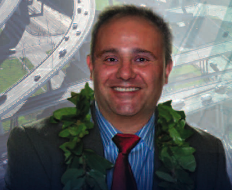Quoted in Richard Borreca's editorial in the April 12 issue of the Honolulu Star Advertiser.
The question is not whether the city’s over-budget, $6.57 billion rail project is good or bad; the question is what are you going to do with this turkey?
Already bailing from the project, estimated to be at least a year behind schedule, is Don Horner, the retired First Hawaiian Bank chairman, who resigned Monday as chairman of the Honolulu Authority for Rapid Transportation.
Council Chairman Ernie Martin last week called for both Horner and HART CEO Daniel Grabauskas to be removed from their positions.
Earlier I asked four of Honolulu’s most perceptive rail critics what they would do if they were running the train instead of Grabauskas and Horner.
The question went to Ben Cayetano, former governor who ran for mayor unsuccessfully on a platform of stopping rail; Scott Wilson, former AIA Honolulu president; Panos Prevedouros, University of Hawaii civil engineer professor and unsuccessful mayoral candidate; and finally Cliff Slater, businessman and longtime rail critic.
First, Slater said, “Grabauskas and Horner should go; they have not been honest with the public about the purported benefits of the project nor have they been forthcoming about the projected costs.”
The problem, Slater said, is that the route should be shortened, but that won’t happen unless “a mayor is elected this fall who is willing to take on the ‘Rail Establishment.’”
Wilson noted that “AIA Honolulu has advocated against elevated rail in central Honolulu since the 1990s when Mayor (Frank) Fasi first raised the idea.”
Honolulu architects aren’t against rail, Wilson argued, but the hope is that an “at-grade, light rail system” would cost less and not devastate the landscape, which will happen with the 20-mile parade of concrete columns and 21 elevated train stations.
Wilson said stopping the heavy rail system at Aloha Stadium or Middle Street and switching the rest of it to light rail, “will save approximately $2 billion over the final 10 miles of the route.”
The UH’s Prevedouros expanded the thinking about the rail system. He said if he were running the rail line, he also would stop the rail line at Middle Street. Then he would “negotiate with FTA (Federal Transit Administration) and instead of the four miles downtown I’d propose adding about 5 miles in the other direction to fully serve Kapolei, Honokai Hale and Ko Olina, including a 4,000-stall park and ride structure for the Waianae Coast commuters. Half of this rail extension could be done at ground level for a much lower cost per mile.”
Monday’s news of Horner’s resignation takes care of half of Cayetano’s first suggestion. Like Slater, he also said he would ask for Grabauskas to resign.
“Both have been less than honest with the public,” Cayetano said.
If the former governor were in charge, the new rail system would be changed into a combination rail and bus system.
“I’d ask the HART board to commit to stopping rail at the Middle Street bus hub and begin planning for a bus rapid transit system running on a dedicated existing lane on King Street to downtown, Ala Moana Center and, if feasible Waikiki,” Cayetano said.
Also, Cayetano would work on a plan to satisfy the federal requirements for spending the transit money without a penalty for changing the plan.
“I would recommend that whatever federal funds have not been used for rail be returned to the FTA ASAP,” Cayetano said.
The existing plan and its execution, Cayetano said, “is a disaster,” but he thinks there is still a way out.
“A bus rapid transit system running on an existing, dedicated lane will avoid the enormous costs of an elevated, heavy-rail system running through downtown; no condemnation of real property will be needed, the huge costs of relocating HECO’s underground utility lines will be avoided and the city’s environment and beauty preserved.”






